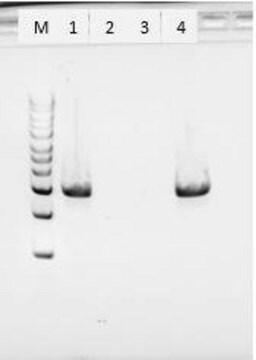RPROTKSOL-RO
Roche
Proteinase K, recombinant, PCR Grade
Solution from Pichia pastoris
About This Item
Recommended Products
recombinant
expressed in Pichia pastoris
Quality Level
form
buffered aqueous solution (18 ± mg/mL; pH 7.5)
specific activity
~2.5 units/mg protein
packaging
pkg of 1.25 mL (03115887001)
pkg of 25 mL (03115844001)
pkg of 5 mL (03115828001)
manufacturer/tradename
Roche
optimum pH
6.5 and 9.5
pH range
4.0-12.5
storage temp.
2-8°C
General description
Application
- This PCR grade Proteinase K is extremely effective on native proteins and can therefore be used to rapidly inactivate endogenous nucleases such as RNases and DNases. This property makes Proteinase K particularly suitable for the isolation of native RNA and DNA from tissues or cell lines.
- The enzyme promotes cell lysis by activating a bacterial autolytic factor.
- Proteinase K is also used for the analysis of membrane structures by modifying proteins and glycoproteins on cell surfaces.
- The enzyme is particularly well suited for isolating nucleic acids for amplification reactions.
- Proteinase K can be used to remove cellular debris during the preparation of colony lifts, and to treat tissue sections to ensure efficient probe infiltration during in situ hybridization.
Features and Benefits
- Choose an effective tool for template preparation. Inactivate DNases and RNases of most species.
- Count on consistent quality and performance. Stringent quality testing ensures optimal stability and high-level lot-to-lot performance.
- Prepare samples over a wide range of conditions. The robust enzyme is stable over a wide pH range and is ideal for diverse applications.
- Benefit from a contamination-free enzyme. The enzyme is tested for the absence of RNases and DNases, and is virtually free of DNA. It is especially suited for the isolation of PCR templates.
Quality
Absence of Nucleases: Each lot is tested on various substrates to ensure the absence of endonuclease, exonuclease, ribonuclease, and nicking activity.
DNA Content: ≤10pg/mg enzyme (determined by Threshold)
Bioburden: ≤5cfu/g (determined by the most stringent test from the European Pharmacopoeia, which identifies the total number of viable aerobic bacteria, yeast, and fungi)
Unit Definition
Preparation Note
Working solution: Suggested Buffers:
The most appropriate buffer for Proteinase K will vary from application to application. Always follow the pH and temperature guidelines in parameter filed. As a general rule, proteinase K is stable and very active in buffers that contain denaturing reagents such as urea, sodium dodecyl sulfate (SDS), and guanidinium salts.
Inhibitors: The enzyme is inactivated by Pefabloc® SC. However, it is not inactivated by metal ions, chelating agents (e.g., EDTA), sulfhydryl reagents, or trypsin and chymotrypsin inhibitors.
Other Notes
The enzyme can reduce protein to free amino acids if it is present in large excess for long incubation periods.
Legal Information
Signal Word
Danger
Hazard Statements
Precautionary Statements
Storage Class Code
12 - Non Combustible Liquids
WGK
WGK 1
Flash Point(F)
No data available
Flash Point(C)
No data available
Certificates of Analysis (COA)
Search for Certificates of Analysis (COA) by entering the products Lot/Batch Number. Lot and Batch Numbers can be found on a product’s label following the words ‘Lot’ or ‘Batch’.
Already Own This Product?
Find documentation for the products that you have recently purchased in the Document Library.
Customers Also Viewed
Articles
Identify causes and remedies for SDS-PAGE sample preparation challenges and optimize electrophoresis conditions.
Our team of scientists has experience in all areas of research including Life Science, Material Science, Chemical Synthesis, Chromatography, Analytical and many others.
Contact Technical Service








